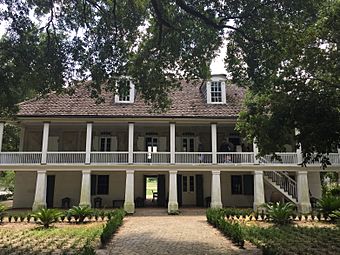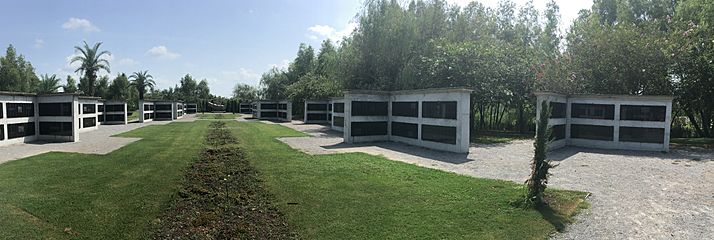Whitney Plantation Historic District facts for kids
Quick facts for kids |
|
|
Whitney Plantation Historic District
|
|

Front of the Big House
|
|
| Nearest city | Wallace, Louisiana |
|---|---|
| Area | 40 acres (16 ha) |
| Built | 1790 |
| Architectural style | Federal, French Creole |
| MPS | Louisiana's French Creole Architecture MPS |
| NRHP reference No. | 92001566 |
| Added to NRHP | November 24, 1992 |
The Whitney Plantation Historic District is preserved by the Whitney Institute, a non-profit whose mission is to educate the public about the history and legacies of slavery in the Southern United States. The district, including the main house and outbuildings, is preserved near Wallace, in St. John the Baptist Parish, Louisiana, on the River Road along the Mississippi River. Habitation Haydel was founded in 1752 by Ambroise Heidal, one of the many German immigrants who colonized the river parishes in the 18th century. His descendants owned it until 1860. In 1867 it was sold to businessman Bradish Johnson who renamed it Whitney.
Overview
The plantation was a 1,800-acre property. Today, 200 acres are occupied by the museum which opened to the public for the first time in December 2014. (The remaining acreage was sold off by the previous owners in the 1970s.) The museum was founded by John Cummings, a trial attorney from New Orleans who has spent more than $8 million of his own fortune on this long-term project, and worked on it for nearly 15 years. The director of research is Dr. Ibrahima Seck, a Senegalese scholar specializing in the history of slavery. The grounds contain several memorial sites dedicated to over 100,000 women, men, and children who were enslaved in Louisiana. In addition, original art commissioned by Cummings, such as life-size sculptures of children, were added to help tell the history of slavery. The sculptures are representative of people born into slavery before the Civil War, many of whom were interviewed as adults for the Federal Writers Project during the Great Depression. These oral histories of hundreds of the last survivors of slavery in the United States were collected and published by the federal government, to preserve their stories. The transcripts and some audio recordings are held by the Library of Congress. Mr. Cummings donated the entirety of the museum and land to a non-profit in 2019.
Historic structures
The French Creole raised-style main house, built in 1790, is an important architectural example in the state. The plantation has numerous outbuildings or "dependencies": a pigeonnier or dovecote, a plantation store, the only surviving French Creole barn in North America (ca. 1790), a detached kitchen, an overseer's house, a mule barn, and two slave dwellings. The complex includes three archaeological sites which have had varying degrees of exploration.
The 1884 Mialaret House, and its associated buildings and property, were added to the complex by later purchase. They help to reflect the long working history of the plantation. Some of the extensive land is still planted with sugarcane.
The Whitney Plantation historic district was listed on the U.S. National Register of Historic Places in 1992. It is one of 26 sites featured on the Louisiana African American Heritage Trail.
Ownership of the Whitney
The Whitney Plantation's land was first bought in 1752, by Ambroise Heidal, an immigrant from Germany. At some point his family changed their surname to Haydel. Upon Ambroise's death, ownership of the land passed to his youngest son, Jean Jacques Haydel. In 1820, this son extended the property to his own sons, who were named Jean Jacques Jr. and Marcellin. Jean Jacques Jr. and Marcellin later bought a plantation next to the property they had been given by their father. After Marcellin's death in 1839, his widow Marie Azélie Haydel ran the plantation during its most productive time, during which it was one of Louisiana's most well-to-do sugarcane businesses. Marie was one of Louisiana's largest slaveholders by the time she died in 1860. Later, in 1867, after the American Civil War had ended, Bradish Johnson became the owner of the plantation, which he renamed Whitney, in honor of his daughter who had married a man with that surname. John Cummings owned the Whitney from 1999 to 2019, and spent over ten years restoring it before opening it to the public. He donated the Whitney in 2019, and it is now a 501(c)(3) organization governed by a board of directors.
See also
- Evergreen Plantation, also in the vicinity of Wallace
- History of slavery in Louisiana
- Louisiana African American Heritage Trail
- List of plantations in Louisiana
- National Register of Historic Places listings in St. John the Baptist Parish, Louisiana
- Plantation complexes in the Southern United States
- Rural African American Museum, Opelousas





